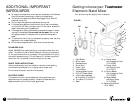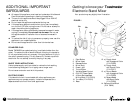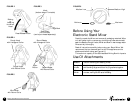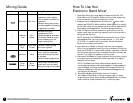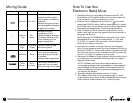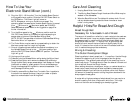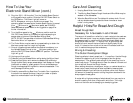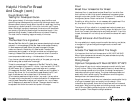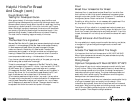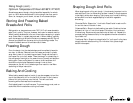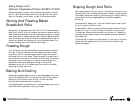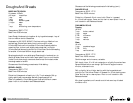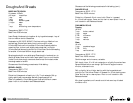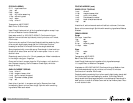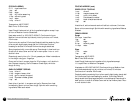
11.10.
Electric Stand Mixer Use and Care Guide
Flour:
Bread Flour Is Essential For Bread
Use bread flour in yeast bread recipes. Bread flour is a white flour
that is a blend of hard, high-protein wheats and has greater gluten
strength and protein content than all-purpose flour. It is available at
most grocery stores. Protein varies from 12-14 percent.
Pre-sifting or sifting the flour is not necessary with yeast bread. First
stir, then spoon into a dry measuring cup and level off.
The amount of flour called for in a yeast bread recipe is meant as a
guide. Dough is affected by heat, humidity, sugar, and altitude. If too
much flour is used, the bread may be very heavy and stiff. If too little
is used, the bread will not hold up and a low-volume bread will result.
Fat:
Dough Enhancer And Conditioner
You may substitute in equal proportions solid shortening, real butter,
or margarine. Light and whipped margarines do not work well.
Liquids:
Activate The Yeast And Bind The Dough
It is important that the liquid temperature is 120°-130°F/49°-54°C.
When higher temperatures are used, the yeast activates too quickly
and the dough becomes too warm.
Rising Dough:
Optimum Temperature Of Room 80°-85°F/27°-29°C
Rising times will vary due to recipe, temperature and humidity level
of your kitchen. Rising is the most essential feature in bread making.
After the dough comes out of the Mixer, the dough ferments and
rises before punching and resting. The gluten becomes pliable and
elastic with a soft, smooth quality. Fermentation conditions gluten,
develops flavor and leavens the product.
Dough has doubled in bulk when an indentation remains after the tip
of a finger is pressed lightly and quickly into the dough. If the
indentation springs back, cover and let rise a few more minutes and
check again. After punching down and dividing dough, cover and let
rest 10 minutes. Resting allows the gluten to relax and makes
handling easier. Then shape the dough as desired.
Helpful Hints For Bread
And Dough (cont.)
Dough Stretch Test:
Testing For Developed Gluten
After approximately 10 minutes of kneading, stop the Mixer and
check the gluten development by performing the dough stretch test.
Remove a small piece of dough about the size of a small egg. Holding
the dough up, carefully stretch it into a flat circle with your fingers.
When the dough is properly developed, the structure will be smooth
and stretchy; light should pass through the stretched dough. If the
stretched dough breaks, it needs a few more minutes of kneading.
The total time for kneading is approximately 10 minutes.
Yeast:
The Number One Ingredient
We used Red Star
®
Active Dry Yeast when we were developing the bread
recipes. A
1
⁄
4
ounce package of Red Star Yeast contains approximately
2
1
⁄
4
level teaspoons of yeast. When the yeast is exposed to oxygen,
moisture or warmth, the activity of it deteriorates. Therefore, we
recommend storing yeast in an airtight container and refrigerating or
freezing it. Measure out the amount you need and allow it to come to
room temperature before using — this takes about 15 minutes.
If you have any doubt regarding the activity of the yeast, you may use
the following test to determine its strength.
To test for one package (2
1
⁄
4
teaspoons) of Red Star
®
Active Dry Yeast,
use a liquid measuring cup and fill it to the
1
⁄
2
cup level with 110°-115°F/
43°-46°C water. Stir in 1 teaspoon granulated sugar and 1 package
(2
1
⁄
4
teaspoons) Red Star
®
Active Dry Yeast. Leave your stirring spoon in
the cup. Set a timer for 10 minutes. As the yeast absorbs liquid, it will
begin to activate and rise to the surface. If at the end of the
10 minutes the yeast has multiplied to the 1 cup mark, it is very active.
The yeast mixture may be used in a recipe that calls for 2
1
⁄
4
teaspoons or
more of yeast. Remember to adjust your recipe for the
1
⁄
2
cup of water
and 2
1
⁄
4
teaspoons of yeast used in the test. The sugar does not need to
be adjusted. Add this mixture with the liquids in the recipe.



